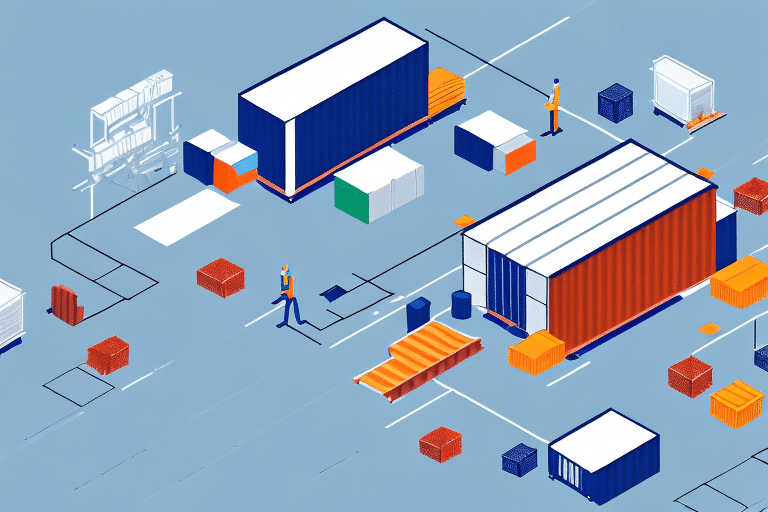How to Successfully Switch from 3PL to In-house Operations
Transitioning from a third-party logistics provider (3PL) to in-house operations is a significant decision for many businesses. When executed effectively, this move can lead to enhanced control, flexibility, and long-term cost savings. This comprehensive guide explores the critical factors involved in making this switch, including the advantages and disadvantages of both models, assessing your company's readiness, developing a strategic plan, building a capable team, implementing best practices, optimizing logistics, conducting cost analysis, tracking success metrics, overcoming common challenges, and insights from industry leaders.
Reasons Companies Transition from 3PL to In-house Operations
Businesses choose to shift from 3PL to in-house operations for various reasons, including:
- Increased Control: Managing logistics in-house allows for greater oversight of the supply chain, ensuring processes align closely with company standards and objectives.
- Flexibility: In-house operations offer the ability to quickly adapt to changes in demand, new product launches, or shifts in market conditions.
- Cost Savings: While 3PLs can reduce costs initially, long-term savings may be realized by eliminating third-party fees and optimizing operations internally.
- Enhanced Customer Service: Direct control over logistics can improve delivery times and product condition, boosting customer satisfaction and loyalty.
- Strategic Alignment: Aligning logistics operations with broader business strategies, such as sustainability initiatives, is easier with in-house management.
For example, according to a Forbes report, companies that transitioned to in-house logistics saw a 15% increase in delivery efficiency within the first year.
Pros and Cons of 3PL vs. In-house Operations
Advantages of Using a 3PL
- Established Infrastructure: 3PLs come with ready-made logistics networks and technologies.
- Expertise: Access to industry experts and best practices without the need for extensive training.
- Scalability: Easily scale operations up or down based on demand without significant capital investments.
Disadvantages of Using a 3PL
- Less Control: Limited oversight over logistics processes and potential misalignment with company goals.
- Communication Challenges: Potential for delays and misunderstandings between the company and the 3PL provider.
- Cost Fluctuations: Long-term costs may increase due to additional fees and lack of pricing control.
Advantages of In-house Operations
- Full Control: Direct management of all logistics processes ensures alignment with business objectives.
- Customization: Tailor logistics operations to meet specific needs and integrate seamlessly with other business functions.
- Potential Cost Savings: Eliminate 3PL fees and optimize operations for long-term financial benefits.
Disadvantages of In-house Operations
- High Initial Investment: Significant capital required for infrastructure, technology, and hiring skilled personnel.
- Resource Intensive: Requires continuous management and dedicated resources to maintain efficiency.
- Risk Management: Responsibility for mitigating risks associated with logistics operations falls entirely on the company.
Assessing Your Company's Readiness for In-house Operations
Before transitioning to in-house operations, evaluate your company's readiness by considering the following factors:
- Current Business Demands: Assess whether your existing logistics needs justify the shift and if your operations can handle increased responsibilities.
- Budget: Ensure sufficient financial resources are available for the initial setup and ongoing operational costs.
- Infrastructure: Evaluate your current facilities, technology, and equipment to determine if they support an in-house model.
- Staff Skills: Determine if your current team has the necessary expertise or if additional training and hiring are required.
- Management Capacity: Ensure that your leadership team can manage the complexities of in-house logistics operations.
According to a Supply Chain Digital, companies that thoroughly assess their readiness before making the switch are 40% more likely to achieve successful outcomes.
Developing a Comprehensive Transition Plan
A well-structured transition plan is essential for a smooth shift from 3PL to in-house operations. Key components of the plan include:
1. Conduct a Supply Chain Analysis
Evaluate your current supply chain processes to identify inefficiencies and areas for improvement. This analysis should cover procurement, warehousing, transportation, and distribution.
2. Define Objectives and Goals
Set clear, measurable goals for the transition, such as reducing delivery times, lowering costs, or improving customer satisfaction.
3. Establish Timelines and Milestones
Create a detailed timeline outlining each phase of the transition, with specific milestones to track progress.
4. Allocate Budget and Resources
Determine the financial and human resources required for the transition, including investments in technology and training programs.
5. Develop Communication Strategies
Ensure clear communication with all stakeholders, including employees, suppliers, and customers, to manage expectations and address concerns.
Building an Efficient In-house Operations Team
The success of in-house operations hinges on building a capable and motivated team. Consider the following strategies:
- Hire Skilled Personnel: Recruit individuals with expertise in logistics, supply chain management, and related fields.
- Provide Training Programs: Invest in ongoing training to keep your team updated on the latest logistics technologies and best practices.
- Foster a Collaborative Environment: Encourage teamwork and open communication to enhance productivity and job satisfaction.
- Implement Performance Metrics: Regularly assess team performance using key metrics to identify areas for improvement and recognize achievements.
Creating a positive work culture can lead to a 20% increase in employee retention, as highlighted by a Logistics Management article.
Implementing Best Practices for Inventory Management
Effective inventory management is crucial for the efficiency of in-house operations. Implement the following best practices:
1. Utilize Advanced Inventory Software
Invest in robust inventory management systems that offer real-time tracking, automated reordering, and detailed analytics.
2. Accurate Forecasting and Planning
Use historical data and predictive analytics to forecast demand accurately, reducing the risk of overstocking or stockouts.
3. Efficient Picking and Storing Protocols
Adopt streamlined processes for picking and storing items to minimize errors and enhance speed.
4. Regular Auditing and Analysis
Conduct frequent inventory audits to identify slow-moving or obsolete items, allowing for data-driven decision-making.
According to a InventoryOps, companies that implement advanced inventory management practices can reduce holding costs by up to 30%.
Optimizing Transportation and Logistics
Transportation and logistics significantly impact operational costs and customer satisfaction. Optimize these processes by:
1. Implementing Efficient Routing Methods
Use route optimization software to determine the most efficient paths for deliveries, reducing fuel consumption and transit times.
2. Leveraging Real-time Tracking and Data Analysis
Monitor shipments in real-time to enhance visibility and respond promptly to any disruptions.
3. Investing in Transportation Management Systems (TMS)
A TMS can streamline logistics operations, reduce errors, and improve shipment visibility.
4. Adopting Automation in Warehousing
Utilize automated systems such as conveyor belts and robotic pickers to increase efficiency and lower labor costs.
A study by Supply Chain Digital found that automation can increase warehouse productivity by up to 25%.
Conducting a Cost Analysis: 3PL vs. In-house Operations
Before transitioning, perform a detailed cost analysis comparing 3PL and in-house operations across various factors:
1. Labor Costs
In-house operations may require hiring additional staff and investing in training, while 3PLs handle labor costs as part of their services.
2. Facility Costs
Assess the costs associated with acquiring or leasing warehouse space, equipment, and technology for in-house operations.
3. Transportation Expenses
Compare the costs of managing your own transportation fleet versus the rates offered by 3PL providers.
4. Technology Investments
Consider the expenses related to implementing and maintaining inventory and transportation management systems.
5. Scalability
Evaluate the costs associated with scaling operations to meet fluctuating demand in both models.
According to a Logistics Viewpoints, businesses can achieve a return on investment (ROI) within 18 months of switching to in-house operations by optimizing key cost areas.
Evaluating the Success of Your Transition: Metrics and KPIs
Tracking the right metrics is essential to evaluate the effectiveness of your switch to in-house operations. Key performance indicators (KPIs) to monitor include:
- Cost per Unit: Measure the total cost involved in producing and delivering each unit to identify cost-saving opportunities.
- Fill Rate: Assess the percentage of customer orders fulfilled without stockouts or delays.
- Delivery Time: Monitor the average time taken to deliver products from warehouse to customer.
- Customer Satisfaction: Use surveys and feedback to gauge customer satisfaction levels with your logistics performance.
- Employee Satisfaction: Regularly survey employees to ensure high morale and address any workplace issues.
- Environmental Impact: Track metrics related to energy consumption, waste production, and carbon emissions to support sustainability goals.
Implementing a balanced scorecard approach can help in systematically tracking these KPIs, as recommended by the McKinsey & Company.
Overcoming Common Challenges in the Transition
Transitioning to in-house operations can present several challenges. Successfully overcoming these requires strategic planning and effective management:
- Staff Training and Development: Invest in comprehensive training programs to equip your team with the necessary skills.
- Infrastructure Setup: Ensure that your facilities and technology are properly established to support in-house operations.
- Process Establishment: Develop and standardize new processes to maintain consistency and efficiency.
- Technology Integration: Seamlessly integrate new technologies with existing systems to avoid disruptions.
- Change Management: Manage organizational changes effectively to minimize resistance and ensure smooth adoption.
According to a Forbes article, companies that proactively address these challenges are more likely to achieve a successful transition.
Expert Insights: Tips from Industry Leaders
Gleaning advice from industry leaders can provide valuable guidance for businesses considering the switch from 3PL to in-house operations:
- Establish Clear Timelines: Set realistic timelines to ensure each phase of the transition is completed efficiently.
- Set Realistic Goals: Define achievable objectives to maintain focus and measure progress effectively.
- Ensure Adequate Staffing: Hire or train sufficient personnel to handle increased operational responsibilities.
- Continuous Process Analysis: Regularly review and refine processes to enhance efficiency and address any emerging issues.
As highlighted by Supply Chain Dive, maintaining flexibility and openness to feedback during the transition can significantly enhance the likelihood of success.
Case Studies: Successful Transitions from 3PL to In-house Operations
Adidas
Adidas transitioned its warehouse operations in-house, resulting in a 20% increase in operational efficiency and a 15% reduction in operating costs. This move also provided Adidas with enhanced control over inventory management and delivery processes, leading to improved customer satisfaction.
Apple
Apple streamlined its logistics by shifting from multiple 3PL providers to a single in-house operations model. This consolidation allowed Apple to reduce delivery times by 25%, increase product availability, and improve overall supply chain visibility.
These examples demonstrate how strategic shifts to in-house operations can lead to significant improvements in efficiency, cost management, and customer satisfaction.
The Future of Supply Chain Management and Its Impact on Your Decision
Supply chain management is rapidly evolving, driven by advancements in technology and changing market dynamics. Future trends to consider include:
- Automation and Artificial Intelligence: Increased use of AI and automation will enhance predictive analytics, streamline operations, and reduce human error.
- Real-time Data Analysis: Leverage real-time data to make informed decisions quickly, improving responsiveness and agility.
- Collaboration and Integration: Enhanced collaboration between supply chain partners will lead to more integrated and efficient operations.
- Sustainability: Growing emphasis on eco-friendly practices will require businesses to adopt sustainable logistics solutions.
Businesses must stay abreast of these trends to ensure their logistics operations remain competitive and efficient. Transitioning to in-house operations can provide the flexibility needed to adapt to these changes effectively.
Conclusion
Successfully transitioning from a 3PL to in-house operations demands meticulous planning, dedication, and significant resource allocation. By following the best practices outlined in this guide, businesses can navigate the complexities of the transition, overcome common challenges, and achieve greater control and efficiency in their supply chain management. Embracing in-house operations can lead to long-term benefits, including cost savings, improved customer satisfaction, and enhanced strategic alignment with business goals.






















